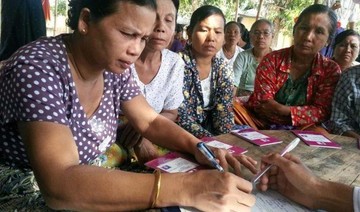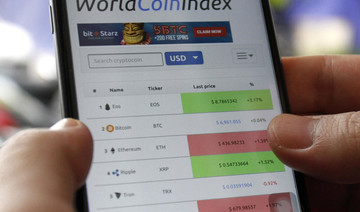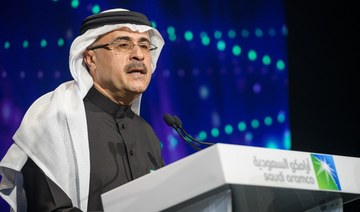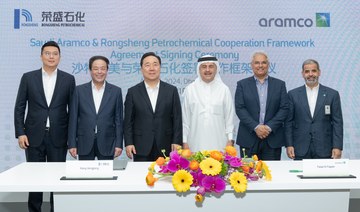NEW YORK/LONDON: Seven years ago, Marshall Hayner gave his grandfather one bitcoin, worth about $30. On the paper wallet he fashioned to commemorate the gift, the US entrepreneur and software developer wrote: “Do not open until $100,000.”
It made Hayner’s grandparents laugh, and indeed bitcoin has not come anywhere near that level. But it is worth more than 200 times what it was in 2011 when Hayner made the gift.
Investors who took a chance on the fledgling currency and stuck with it have been on a rollercoaster ride — but are optimistic that they are still onto a winner.
“I have seen these run-ups and drops in bitcoin and I did not even flinch,” said 34-year old Hayner, who started mining bitcoins in 2009 when the granddaddy of all cryptocurrencies was worth nothing. He also founded payments company Metal Pay.
“I believe in this technology. I really believe that bitcoin is the next digital gold,” he said in an interview this week.
Bitcoin on Wednesday celebrates ten years since Satoshi Nakamoto, bitcoin’s mysterious founder, released a whitepaper outlining the need for an Internet currency that could be used as payment without going through a third party like a bank.
One bitcoin is now worth around $6,200. That is a steep 70 percent fall from its all-time high of near $20,000 in December last year, hurt by a more intense regulatory scrutiny around the world, as well as the rise of cryptocurrency crime including hacking, but a substantial boost for any early investors who bet on it.
“If the price goes down, I am happy because I was able to sell some,” said Israeli entrepreneur Daniel Peled, who has bought since late 2013 and believes another record peak is a few years away. “And if it goes up, I am happy too because I am still holding some.”
Peled’s optimism is partly based on his waiting for bitcoin’s next “halving,” which has constrained its supply and has caused its spike as demand increased.
Bitcoin relies on so-called “mining” computers that validate blocks of transactions by competing to solve mathematical puzzles every 10 minutes. In return, the first to solve the puzzle and clear the transaction is rewarded new bitcoins. Bitcoin technology was designed in such a way that it cut the reward for miners in half every four years, a move that was meant to keep a lid on inflation.
The next halving is scheduled in 2020 and the following year should be a good year for bitcoin, Peled said.
The same optimism has prompted London-based investor Nicholas Gregory to keep his bitcoins, which he bought heavily in early 2014.
Distrustful of exchanges, Gregory, currently chief executive of blockchain firm CommerceBlock, made his first purchase through a website that matched him to a man selling bitcoins on a memory stick in a New York cafe.
Since then, he has not sold any bitcoins, citing the potential of the digital currency to safely store value and transfer money across the Internet.
Lost potential?
Some investors, however, have become disillusioned, arguing that bitcoin has been held back and not reached its expected potential by taking off in the real world.
Vaughn Blake, a Los Angeles-based portfolio manager at private equity firm Echo Tree Capital, liquidated his cryptocurrency quantitative fund in January this year when bitcoin was at $13,000. He started investing in bitcoin in 2013 when it was around $120 but said he has been a victim of hacks and phishing attempts.
Bitcoin’s technology has also not always been an efficient means of processing payments. It can be slow, sometimes incurring higher fees than regular transactions, market participants said.
London-based entrepreneur Jez San, CEO of blockchain firm Funfair Technologies, started buying bitcoin in 2013, at around $50, but sold most of it well before the peak in December 2017. He invested in Ethereum, the second-largest cryptocurrency that runs on another public blockchain network, instead.
“We all expected people would be buying coffees with it and they would use it instead of PayPal,” said San. “Bitcoin is way too hard to use — it’s so user unfriendly that the man in the street just can’t use it.”
Early bitcoin investors count winnings after volatile decade
Early bitcoin investors count winnings after volatile decade
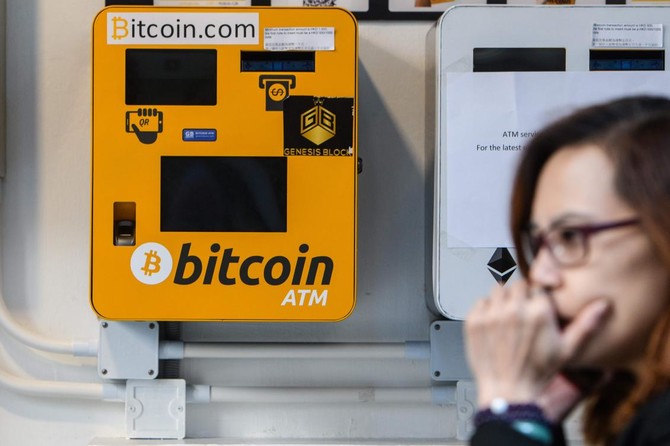
- Bitcoin relies on so-called “mining” computers that validate blocks of transactions by competing to solve mathematical puzzles every 10 minutes
- Some investors, however, have become disillusioned, arguing that bitcoin has been held back and not reached its expected potential by taking off in the real world
IsDB, SFD, Arab Coordination Group join hands to raise $500m for education initiatives
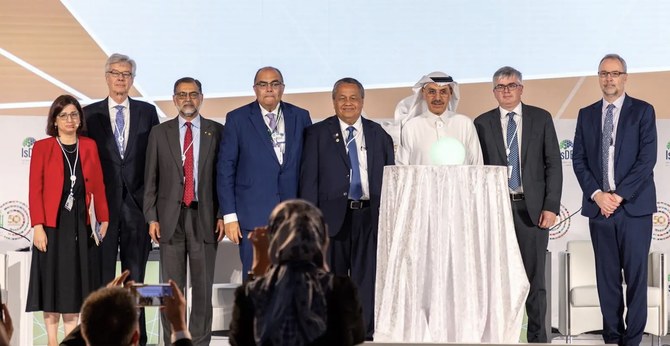
RIYADH: A global partnership involving the Islamic Development Bank will inject $500 million into educational initiatives across member countries of the Organization of the Islamic Cooperation.
During the annual meetings and golden jubilee celebrations of the IsDB, the Arab Coordination Group and the Saudi Fund for Development also joined The Global Partnership for Education, the Saudi Press Agency reported.
The Global Partnership for Education is a multi-stakeholder partnership and funding platform that aims to strengthen education systems in developing countries.
The amount will be raised by the Smart Finance for Education Initiative, an innovative financing tool.
Moreover, partners also pledged an additional $350 million to the initiative, including $150 million from the IsDB, $100 million from the Arab Bank for Economic Development in Africa, and $50 million from The Islamic Solidarity Fund for Development as well as $50 million from the Global Partnership for Education.
The initiative aims to enhance access to quality education in 37 OIC member countries, where 28 million children are without schooling.
Also at the event, the Islamic Corporation for the Insurance of Investment and Export Credit, a member of the IsDB concerned with providing Shariah-compliant insurance services, signed a retakaful agreement for a percentage of the shares allocated to Indonesia for the benefit of the country’s Eximbank.
A retakaful agreement is an Islamic reinsurance contract where takaful operators transfer a portion of their risk to a retakaful operator in compliance with Shariah principles.
The arrangement aims to provide strategic expertise and capabilities in the field of retakaful through a quota-sharing treaty specifically designed to support the launch of the financial institution’s new export credit takaful program product.
This comes as the business expected to be insured under this treaty is estimated at a value of $13 million during the year 2024.
During the IsDB annual meetings and jubilee celebrations, the bank’s president, Mohammed Sulaiman Al-Jasser, confirmed that the entity has designed a strategy for eco-conscious growth and low carbon reduction by supporting members to reach the zero-carbon goal.
Al-Jasser also pointed out that 40 of the bank’s projects are about renewable energy, green projects, and financing climate action.
He underlined the bank’s focus on green initiatives and sustainable development sukuk, indicating they are compatible with the Capital Markets Union standard.
The IsDB’s 2024 annual meetings are being held under the patronage of King Salman bin Abdulaziz in Riyadh from April 27 - 30.
The annual sessions coincide with IsDB’s golden jubilee, as the institution celebrates 50 years of promoting economic and social development in 57 member nations under the slogan “Taking pride in our past, shaping our future: authenticity, solidarity, and prosperity" reflecting the bank’s legacy and future goals.
Closing Bell: TASI closes in green; Saudi banks profits up
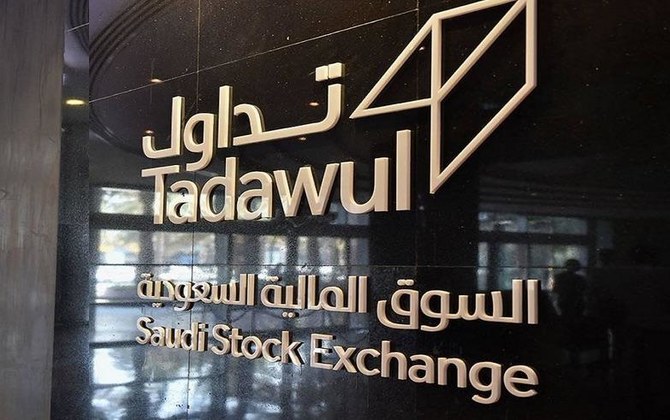
RIYADH: Saudi Arabia’s Tadawul All Share Index wrapped up Monday’s trading session at 12,369.46 points, witnessing an increase of 137.92 points, or 1.13 percent.
The parallel market, Nomu, ended the day at 26,227.72 points, shedding 3.11 points or 0.01 percent.
Conversely, the MSCI Tadawul Index grew by 24.35 points to close at 1,569.81, a 1.58 percent increase.
TASI reported a trading volume of SR8.2 billion ($2.19 billion), with 165 stocks making gains and 63 witnessing declines.
Nomu, on the other hand, saw a trading volume of SR52 million.
On the announcement front, Al Rajhi Bank reported an increase in profits to SR4.4 billion for the first quarter of 2024, reflecting a 6 percent rise from SR4.1 billion recorded during the corresponding period in 2023.
The bank primarily attributed this growth to a 10.2 percent increase in net income from financing and investment activities, driven by a rise in total income on financing and investment.
This was further supported by an increase in total returns on these investments, according to a bourse filing.
Its operational income also saw a healthy increase, rising by 6.6 percent due to gains in net financing and investment income alongside income from other operations.
However, these gains were partially offset by a decrease in income from banking service fees and foreign currency exchange activities.
On the expenditure side, total operating expenses, including provisions for credit losses, rose by 7.2 percent. This increase was largely due to higher depreciation costs and employee salaries and benefits.
Despite these rising costs, the bank managed to mitigate some financial pressures with a reduction in other general and administrative expenses. Notably, provisions for credit losses escalated significantly, from SR359 million in the previous year to SR421 million in 2024, reflecting a 17.3 percent increase.
Furthermore, Bank Albilad also saw an increase in profits as it released its first quarter results.
The bank reported a 15 percent increase in profits, reaching SR643.1 million up from SR559.9 million in the same quarter of the previous year, according to a bourse filing.
The increase in profits was primarily attributed to a robust performance in its investment and financing assets, which saw a 21 percent increase in income.
This significant growth in asset income helped offset the 54 percent rise in the return on deposits and financial liabilities, underlining the bank’s effective management of its asset portfolio against rising costs.
Additionally, Saudi National Bank also managed to secure an increase in profits in the first quarter. The bank reported a marginal rise in its profits to SR5.04 billion from SR5.02 billion during the same period last year.
This modest increase in profits was underpinned by a significant 21.9 percent rise in special commission income, driven largely by growth in the bank’s financing and investment portfolios, coupled with rising interest rates.
The bank also experienced a slight 0.4 percent increase in net income attributable to shareholders, buoyed by a 2.4 percent improvement in total operating income and gains from other non-operational financial activities.
However, petrochemical company Saudi Kayan reported a loss in its first quarter results. Despite the ongoing challenges, the company managed to reduce its losses to SR571.9 million from SR673.3 million in the same quarter the previous year.
Saudi Kayan attributed the narrowed losses primarily to an increase in revenues, spurred by higher sales volumes, which helped counterbalance the impact of lower average product selling prices.
In a Tadawul filing, the company noted that while the average selling prices had decreased, the overall financial performance improved compared to the previous year.
Saudi Aramco retains its status as Middle East’s most valuable brand
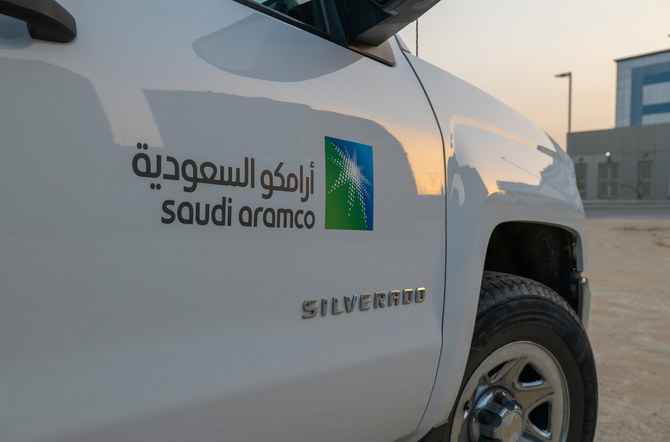
RIYADH: Energy giant Saudi Aramco has maintained its position as the Middle East’s most valuable brand, with a value of $41.5 billion, according to a report.
The latest analysis by Brand Finance revealed the firm continued to dominate the region despite an 8 percent drop in value, driven by a fall in crude oil prices and lower sales volumes.
The report noted that a 12 percent increase in brand value to $13.9 billion meant the Kingdom’s telecommunications firm stc was ranked as the second most valuable in the Middle East and the region’s most sought-after telecom company.
Andrew Campbell, managing director of Brand Finance in the Middle East, said that stc is steadily progressing as one of the leading telecommunications firms globally.
“While Aramco remains the dominant player in terms of brand value in Saudi Arabia, stc’s strategic acumen, characterized by ongoing diversification and digital transformation, have further solidified the brand’s status as Saudi Arabia’s strongest brand, while also positioning it among the world’s leading telecoms brands,” said Campbell.
The report noted that stc encompassed “an integrated system of subsidiaries specialized across sectors, alongside its traditional telecommunications services.”
It add that the company’s acquisition of an interest in Telefonica “marks another key milestone in stc’s growth journey.” said Brand Finance.
With a brand value of $6.4 billion, Al Rajhi Bank became the third most valuable firm in the Kingdom.
Saudi Basic Industries Corp. and Saudi National Bank were ranked fourth and fifth, respectively, with values totaling $4.9 billion and $4.5 billion, respectively.
Saudi Arabia’s King Faisal Specialist Hospital & Research Center, with a value of $1.5 billion, became the Middle East’s most valuable Healthcare label, the report added.
In the UAE, Abu Dhabi National Oil Co. was named the most valuable brand, with a value of $15.2 billion.
On the other hand, Qatar National Bank was ranked the top-rated brand among Qatari firms, with a value of $8.4 billion.
Islamic finance industry projected to grow in 2024-2025
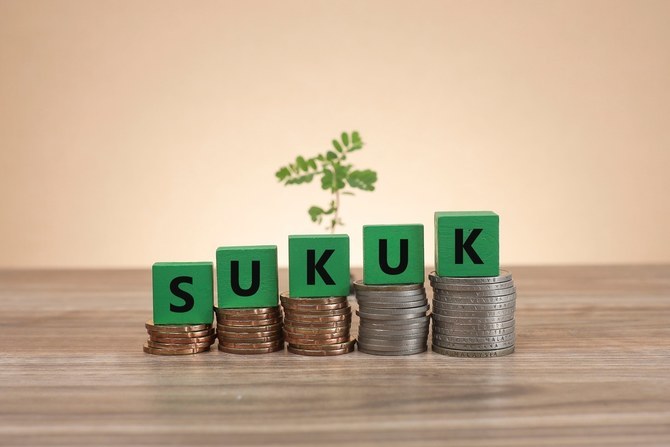
RIYADH: The Islamic finance industry is projected to grow globally in 2024-2025 with total assets likely to witness single-digit growth driven by economic diversification efforts, a report said.
It predicted that sukuk issuance globally would hover between $160 billion and $170 billion in 2024, representing a steady momentum from $168.4 billion in 2023 to $179.4 billion in 2022.
In its latest analysis, credit rating agency S&P Global highlighted that the industry grew by 8 percent and 8.2 percent in 2023 and 2022, respectively, stemming from growth in banking assets and the sukuk industry.
According to the US-based firm, Islamic banking assets grew 56 percent in 2023 compared to 72 percent in 2022.
Financial institutions across the Gulf Cooperation Council region accounted for 86 percent of the reserve increase in 2023, with Saudi Arabia becoming the chief contributor, having generated 56.7 percent of the maturation.
“We expect the implementation of Vision 2030 and growth in corporate and mortgage lending to continue supporting the Islamic finance industry over the next 12-24 months. In addition, the UAE showed a stronger contribution in 2023 thanks to the good performance of the non-oil sector,” the report noted.
It added: “Elsewhere, we observed some growth, particularly in Turkiye and Indonesia. The performance in Malaysia and Turkiye was somewhat tempered by the depreciation of the ringgit and the lira.”
According to the US-based firm, the issuance of this Shariah-compliant debt product began on a strong footing in 2024, with Saudi Arabia becoming a key contributor to the performance.
“The drop in issuance volumes in 2023, which mainly resulted from tighter liquidity conditions in Saudi Arabia’s banking system and Indonesia’s lower fiscal deficit, was somewhat compensated by an increase in foreign currency-denominated sukuk issuance,” S&P Global said in the report.
It added: “The market has started 2024 on a strong footing, with total issuance reaching $46.8 billion at March 31, 2024, compared with $38.2 billion at March 31, 2023.”
The analysis highlighted that the sukuk market will continue its growth momentum in the near term as financing needs in core Islamic finance countries remain high, given ongoing economic transformation programs, especially in countries like Saudi Arabia.
“We expect the sukuk market to fill in some of these needs. Specifically, we see some opportunities in the structured finance space with banks tapping the sukuk market to refinance their sizable mortgage books,” said the agency in the report.
The agency highlighted that the drive for digitalization and sustainability initiatives have yielded mixed results in the Islamic finance industry.
“While opportunities related to sustainable finance are significant as the industry is concentrated in oil exporting countries, progress has been relatively slow and limited in the global context,” according to S&P Global.
However, the report noted that digitalization has helped the banking side of the industry.
S&P Global concluded the study by saying that the future of Islamic finance is sustainable, collaborative, and digital.
“It is sustainable thanks to the alignment between Shariah principles, overarching pillars of sustainability, and the value proposition of Islamic finance that capture more than just financial objectives,” said the report.
According to the analysis, the future of Islamic finance is collaborative because stakeholders do not want to disrupt the industry equilibrium and erase the development achieved over the past 50 years.
The report added that digitalization will also impact Islamic finance in the coming years, as leveraging emerging technologies could help the industry enhance its efficiency and ultimately increase its value proposition for investors and issuers.
Earlier this month, another report released by Fitch Ratings noted that global outstanding sukuk expanded 10 percent year on year to reach $867 million at the end of the first quarter of 2024.
The credit rating agency attributed the growth of this Islamic debt product to funding and refinancing needs, and the development of the debt capital market in the GCC region.
The report, however, added that new Shariah requirements that could alter credit risk, geopolitical uncertainties and high oil prices, could affect the growth of the sukuk market this year.
Saudi Aramco is looking at investment in new energies outside of the Kingdom, CEO says
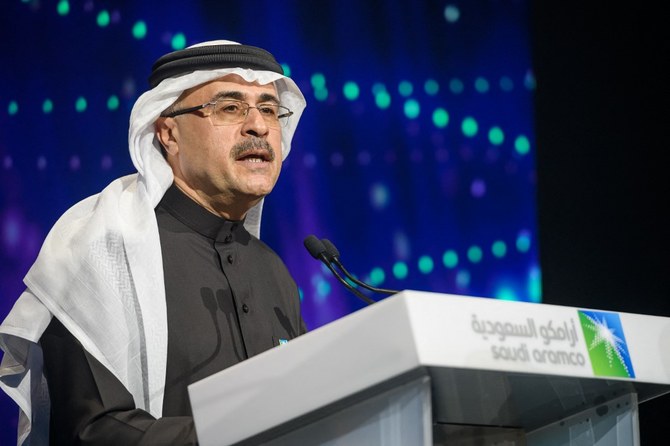
DUBAI: Saudi Arabia’s state-oil giant Aramco is looking at investments right now in new energies outside of the Kingdom, CEO Amin Nasser said on Monday at the sidelines of a World Economic Forum special meeting held in Riyadh.


